Some approaches to Sound and Listening.
My practice has a pluralistic approach to the sonic domain and embraces several strands of conceptual and technological development. These in turn are manifest in a variety of modes, which range from gallery based interactive works, to environmental public sound works to Research and Development programmes in spatially located immersive soundscapes. As an introduction this document outlines four broad areas of current activity.
Mode #1 ~ Interactive + Performative + Inductive.
Working with incredibly simply induction systems (I would be embarrassed to call them technologies) these installations present ‘fields’ of mono sounds which may only be ‘discovered’ with the aid of a portable device; in the case of “Seed” a mine-sweeper and in “The Naughty Apartment” a magnifying glass. These installations demand a high degree of performance form the participants moving between and mixing sources. The works induce a sense of (re)enchantment as the sound sources are delivered by non-acoustic means. This approach could easily be adapted to employ RFID technology and linked to portable MP3 type devices.
Seed.
Physical ~ “Seed” consists of x16 prayer mats (@ 1000mm x 600mm). Resting at the centre of each is a small facsimile landmine (each 70mm diameter x 50mm). The footprint of the installed work is variable but is nominally contained within a 7000mm x 7000mm area. In addition there is a wall mounted rack supporting five small ‘detector’ units and an equipment stack comprising a x16 channel hard-disc machine, a x16 channel amplifier and power supplies.
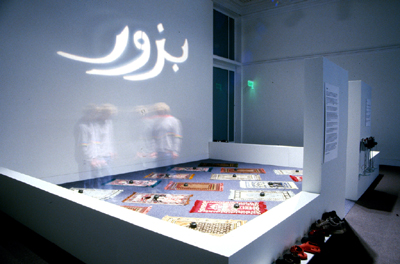
Conceptual ~ In English we speak of mines sown in fields or laid somewhat akin to an egg, or perhaps a cunningly laid trap. This is a domestic and agricultural lexicon whose familiar words belie the barbarous intent of these small kernels of violence.
Mines are ontological devices; they lie in wait for the future! Such a concept is resonant with the Old Testament parable of the sowing of seed, in which the germs of the future are broadcast, as if by chance, across a varied range of terrain, some fertile and fruitful, and some stony and barren, in an ecology of destiny. In a more obvious combination of the fruitful and the fatal, we might recall the recent aerial seeding of Afghanistan with small yellow packages, some round and some square, some containing food but others deadly ordinance.
Whilst the physical geography of Islam acts as the historical context for the mytho-poetic spaces and narratives of the Old Testament so to it acts as a repository for hundreds of thousands of landmines – a testament to the failure of military solutions to generations of economic and political instability. Should we heed the adage “As you sow, so shall you reap” then an optimistic future in the region is less than assured. “Seed” is a sonic installation that metaphorically collides our agricultural lexicon of the minefield with the narratives of the Old Testament and the contemporary disasters of military and ideological conflict. It does so by inviting the viewer/auditor to literally enter a sonic-minefield. Each visitor may equip themselves with a simple mine-detector that will allow them to listen in to the sonic terrain emitted by the mines.
Perhaps to their surprise, the small facsimile landmines, each resting at the centre of an Islamic prayer mat, do not voice strident political commentary, the sounds of battle or doctored media grabs! Instead the encounter is with a sonic world of looped Arabic music, some ancient and some contemporary, overlaid with voices, in Arabic and English, which enunciate the ninety nine names of Allah, each name supported by a brief extract from the Koran.
“Seed” therefore proposes a place of complexity and ambiguity within which to contemplate the simplistic and unilateral position of current military and political events. It is after all sobering to consider that the death toll inflicted by landmines (principally in the developing world) is equivalent to the appalling destruction of the World Trade Centre – repeated five times each year. (2002).
The Naughty Apartment.
Physical ~ The project consists of two functional elements; a series of architectural models (x8) capable of ‘transmitting’ audio, together with a series of hand held ‘viewer/receiver’ units (x10).
Each model is constructed from laser cut acrylic elements and is designed to contain a miniature scene (more or less loosely interpreted from Bulgakov’s novel). The model are about 300mm x 200mm x 250mm and is mounted on a freestanding plinth 1000mm high.
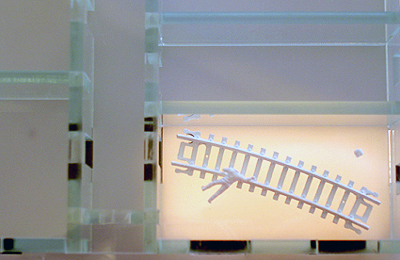
The Viewer/Receivers.
As a visitor positions the lens of the ‘viewer/reader’ close to the model in order to magnify the miniature scene within the model, the device begins to relay a soundtrack that relates to the scene. Once again, the soundtrack will be more or less, loosely interpreted from the novel but will extend both the narrative and the spatial context.
The hand-held mobile objects are about 270 mm top to bottom and about 30mm thick – all laminated from clear acrylic with an electronics box + headphones mounted on each.
Conceptual ~ I am one of those readers who become obsessed with certain authors and who rapidly exhaust their oeuvre (naturally becoming despondent when the supply of novels dries up!). The Russian writer Mikhail Bulgakov is one of these passions and in particular the magic realist novel “The Master and Margarita” which was completed in 1940 (but only published in 1966) and which caused a sensation in Soviet culture. To cut a long and complicated story short “The Master and Margarita” is an allegorical and darkly satirical tale recounting a visit to Moscow by Satan and his entourage to conduct “Satan’s Ball”. Much of the action unfolds within the writer’s own apartment (the infamous apartment No.50 of 302-bis Sadovaya Street) the work drawing its title from Chapter seven of the novel.
As fate would have it the Bulgakov apartment still exists and currently enjoys a shrine like status – a site of pilgrimage for Bulgakov buffs. Although it might seem an impossible task negotiations are taking place with the concierge of No.50, to eventually install the “Naughty Apartment” in the naughty apartment and so to speak, complete the circuit!
Essentially the work deals with how we engage with fictional spaces and narratives – and the slippery methods that allow us to incorporate and ‘carry’ these fictions within us. What are the processes by which we internalise and hybridise such forms which have only ever existed as descriptions? And how, and why, do we embroider and super-impose fictional structures upon tangible everyday reality?
As I attempted to transpose Bulgakov’s narratives into (miniature) sculptural dioramas another form of slippage occurred. The discontinuous narrative that is woven by the fluid spatial and temporal fabric of the novel is only uneasily congealed into a sculptural tableau. The textual events, constructed via a montage of narrative appear strangely like a Medieval ‘continuous narrative’ frieze when it is recruited to perform in a frozen three-dimensional structure.
The sonic domain comes to the rescue here, re-supplying a narrative flow to the collective tableaux – certainly not in an attempt to re-create the complex narrative of the entire novel, but rather as a series of vignettes which meditate upon the notion of location, locale and spatial identity within which fictions may unfold.
‘The Naughty Apartment’ attempts to reconcile a personal imagination of a fictional (but physical) space underwritten by the ironic knowledge that this fictional location was (and remains) a physical reality.
In this category see also “The Transit of Venus”
Mode #2 ~ I.D.E.A.S. (Interactive Digital Environmental Audio Sculptures).
IDEAS. is a long term project that I am slowly developing and expanding. The principal aim is to create a series of modular, multi-unit, environmental sound sculptures which exhibit increasing complexity and sophistication. The electronic systems within these sculptures are be robust enough for permanently installation in outdoor environments, are self-powered (solar) and have the capacity to store, mix and replay good quality audio. In addition, the units forming the environmental sound-sculpture (an ‘ensemble’) will display some forms of A.I. (say interactions with environmental conditions, fauna or human presence or the sound activities of proximate units).
Meta-Diva
“Meta-Diva” is an environmental Sculpture which incorporates a solar powered, digital audio soundscape. The structure of the sculpture employs the metaphor of plant biology and consists of a grouping of thirty units (as in a bed of Lotus plants).
Each unit comprises; a 3.5 metre tall ‘stem’ which in turn supports a small solar panel and terminates in a ‘florette’ formed of a central ‘bud’ surrounded by eight small exponential speaker horns (each unit = 0.5metres diameter).
The sculpture is constructed in Aluminium, the top element being spun and welded Aluminium, and all surfaces are powder-coated. The Solar panel and the Audio electronics are fully marinised and require zero maintenance, there are no batteries, no switches and no moving parts! The work has been designed for public installation, in a lakeside context, with a minimum of ten years operational life before maintenance is required.
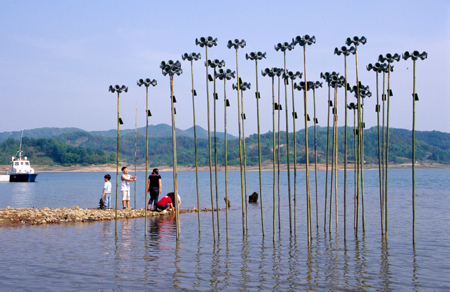
The Soundscape.
Each unit contains a miniature digital audio chip, coupled to a digital timer, set individually so that each of the thirty units has a unique time signature. The audio chips contain short samples of natural history sounds, bird song, insect song and frog voices.
The combination of multiple sound sources, in conjunction with individual time signatures and the fluctuations of the solar power supply give the soundscape an un-cannily ‘natural’ presence. Technically, this a type of ‘emergent behaviour’ in which although we might hear individual elements repeat, the overall soundscape is in fact an infinite mix (somewhat like the always familiar, but never repeating sounds of a creek).
In reality the soundscape blends so seamlessly with the natural environment it if quite difficult to distinguish the ‘artificial’ from the ‘natural’ background.
Haiku.
“Haiku” is a multi-part solar-powered environmental sound sculpture that distributes a series of traditional Japanese poems via miniature digital audio storage units operated by solar timers.
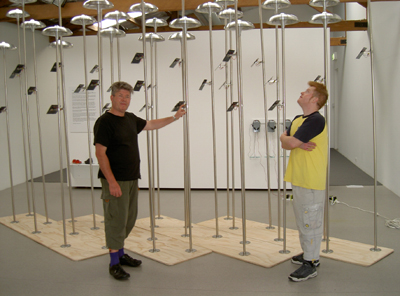
A new solar accumulator/timer circuit was developed to permit this project to operate indoors. Slight variations in power availability cause variations in audio chip activation with the consequence that the ‘ensemble’ produces an ‘infinite-mix’ of thirty voice phrases, never repeating exact patterns.
Dual-Nature.
The environs of Woolloomooloo Bay are formed by the pro-active natural history interests vested in the Domain and Botanic Gardens on one flank and by the military/industrial interests of the Federal state on the other. In essence the waters of the bay span a duality of nature and industry.
Again – that these waters support the navigation of both the Navy and the Citizenry is quite unique and invokes a further doubling of the tidal metaphor of Ebb and Flow. The bay is a site of Ebbing – as the point of departure for thousands of Australians and hundreds of Australian ships, mobilised in the interests of Empire, a site with many departures but sadly fewer returns.
But these waters are also the recipient of Flow – as a place which received thousands more souls, traveling on ships as new emigrants to Australia, there is an ironic balance here, a flux in the nature and identity of our culture. The metaphor of Ebb and Flow is developed as a significant leitmotiv within the work both as a sculptural trope and as a keynote within the sonic treatment.
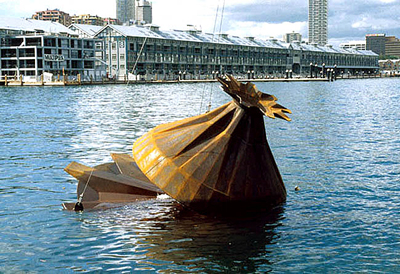
Dual Nature is designed primarily to be a hybridisation of forms derived from natural history, marine architecture and industrial structures. A second key factor is commensurate with my practice as a sound-sculptor – the proposed work combines a sculptural presence with a soundscape working together in a strong synergy.
At the core of the work is a series of four sculptural objects, which meld marine shell forms with industrial structures and fabrication techniques. This typology of spherical and conic forms co-join the growth spirals of nature with the more ominous engineered marine types found in submersibles, sea mines, etc.
Two of these shells are positioned on the rock ledge of the foreshore so as to be partly submerged at high tide but predominantly exposed at low tide. They are be constructed as compound curved objects from 10mm mild steel plate (folded and welded) being designed to slowly corrode and become encrusted with marine growth. A stainless steel derricks, or cranes, mounted at the edge of the stone platform are linked by steel cables to each shell object in order to provide a visual metaphor, of retrieval or launching, thus forming a strong referential link to the maritime history of Garden Island.
These semi-submerged shell objects are intended to act as natural reverberation chambers endlessly changing tone as the tide gradually fills and empties their interiors.
A second series of two shell forms rest on the old sandstone structure (once the platform for the “Figtree Baths”). These structures, are intended as a strong reference to the shipyards across the bay, complimented and extended by the incorporation of the ebb and flow soundscape installed within each of these land mounted structures.
The Ebb and Flow soundscape is composed from multiple interwoven elements of voice narrative drawn from the historical context of Wooloomooloo, addressing in particular, the constant flow of people and shipping. Historical material has been drawn from textual records and wherever possible from sound archives. The soundscape is digitally stored in solid-state MP3 audio chips and designed to operate as an infinite mix (ie non-linear and thus non-repetitive soundscape). The audio systems are physically incorporated within the sculptural objects as stand-alone units and are powered by solar panels mounted at the tip of each crane element.
Theorem (Artists in Labs programme).
How might an Artist approach the Paul Scherrer Institut, which by any standards, is a complex intellectual and social organism? My strategy, simplistic though it may seem, has been to imagine PSI as eco-system, or more specifically, from my Sound Sculptor’s perspective, as an acoustic-ecology. My principal task being how to get under the skin of the life of PSI and create a work that will encapsulate aspects of PSI in the form of an abstract ‘audio-portrait’, whilst simultaneously employing some of the Lab’s technology and expertise.
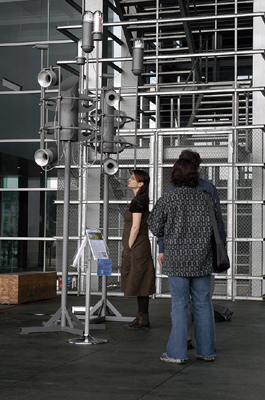
The “Theorem” project is conceived as an ensemble of individual audio producing sculptures with acoustic behaviours that are modelled upon the subtle balance of order and chaos found in the natural environment. In a natural setting we are surrounded by multiple discreet sound sources, belonging to a variety of acoustic types (for example bird song, insect noise etc) but most of which share some type of collective or community behaviour (for example call and response in bird song and excitation behaviour in insect communities).
“Theorem” will be based upon a modular design in which an array of 30 to 40 audio units, form a complex interactive ‘ensemble’. A Cosmic Muon, detection device, will trigger each unit and variations in the detection rate will be employed to select from a palette of audio files, ensuring a complex ‘composition’ across the array. Further interactive complexity will be supplied by human proximity detection and acoustic detection. Each of the “Theorem” units will carry a large but identical cache of audio files organised into several play-lists, or families of sounds. Each play-list will contain songs (individual audio files) that are intentionally designed to have different durations and which, combined with the wide variety of form and texture of play-list content, will ensure a rich complexity and contrast in the overall soundscape.
The Sound Design of “Theorem” is intended to render an abstract portrait of the PSI Laboratories and its Scientific Community. Material is drawn from a variety of sources, which include recordings of Laboratory atmospheres and ambiences, employing conventional microphony, Electro Magnetic recording and Vibration recording.
I have also been conducting brief recorded interviews with the Scientific Staff of PSI who have been asked to outline their concepts of elegance and beauty within the scientific paradigm and to pronounce an example of an elegant equation. These sounds of the internal life of PSI will be accompanied by content collected from the wider physical rural environment in which the PSI Laboratory is located, including a tonal palette of Cowbells etc.
Physically the multiple units of the ensemble will consist of a grouping of slender masts with lateral branches supporting ‘pods’ that contain the various technical elements of the work (Muon detector, Audio storage and playback, amplifiers and speakers etc). The masts will also carry an array of small but high intensity LED lights at their tip which will be linked to the Muon detection rate and to the audio file selection – giving a visual cue to the operational status of each unit and thus the ensemble as a whole.
Mode #3 ~ Bio-Sonics.
Projects under this grouping arise from my long-term interests in natural history and the environment. However it has only been recently that I have been able to work collaboratively in Bio-Science laboratories and the resulting projects are samples of my initial attempts to explore the conjunction of biological with sonic systems.
Host.
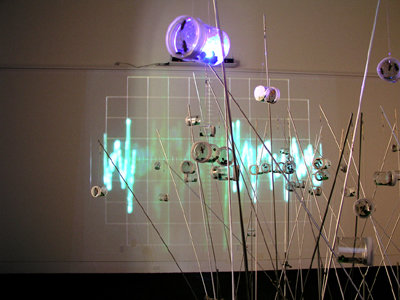
Host” is an installation developed recently at the ‘SymbioticA’ Bio-Art and Technology Laboratory (University of Western Australia) in which an audience of live Crickets attend a lecture concerning the sex life of insects. The lecture, in the form of two DVD projections, has one sound track recorded directly from the speakers voice, whilst the other was recorded directly from the aural nerve of a Cricket, in effect employing the insect’s acoustic system as a primitive microphone. If nothing else, this installation is ample proof that our own sex lives are much less interesting than we suppose!!!
GeneMusiK.
GeneMusiK is an experimental biological music mixing and generating system currently under development by Dr Nigel Helyer at the Faculty of Natural and Agricultural Sciences, Univesrity of Western Australia under the aegis of ‘SymbioticA’.
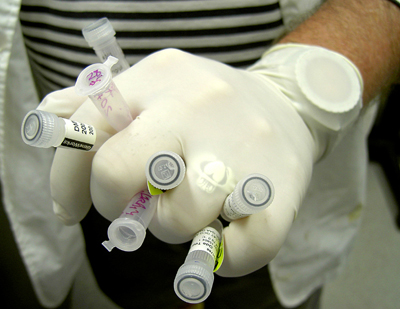
The GeneMusiK project is designed to establish a functional relationship between conventional Western musical scales and DNA sequences and produce a system for mixing and mutating musical form within a biological context.
Whilst there have been several interesting attempts to transliterate DNA code into musical forms and notation these have invariably been theoretical analogues
GeneMusik departs from previous experiments in that it is an entirely ‘wet’ process, which employs chemical and biological means to achieve musical transformations. Rather than taking given DNA structures and rendering them as musical code, GeneMusik takes fragments of conventional Western melody and sequences them as DNA that is subsequently ‘bred’ and ‘mixed’ within bacterial cultures.
DNA extracted from these cultures may then be re-sequenced, translated to musical notation and interpreted as new musical forms.
It is anticipated that the first public manifestation of GeneMusiK will be a series of elegant body adornments that contain ‘musicalised’ synthetic DNA sequences. Each item will be accompanied by a certificate of authenticity and an audio CD of the musical sequence
Subsequent editions are envisioned that will contain DNA sequences hybridised within bacterial cultures, together with installations of living ‘musical low-life’.
GeneMusik may be exhibited as a series of miniature static objects (i.e body adornments) accompanied by photographic panels (laboratory process and notational materials) together with audio recordings of the DNA translations.
LifeBoat.
The lifeboat project is a complex combination of a psychological profiling station and a tissue culture facility, all crammed into the confines of a Marine Lifeboat and manifest as an ongoing performance with a crew of four. Lifeboat was trialled in 2004 in Oslo and then made a major appearance on the decks of the “Opera” a Baltic cruise liner as part of ISEA2004. Lifeboat is included here as it employs some of my DNA to Music work, in that the results of the psychological processing are expressed as DNA code which is then translated into musical sequences.
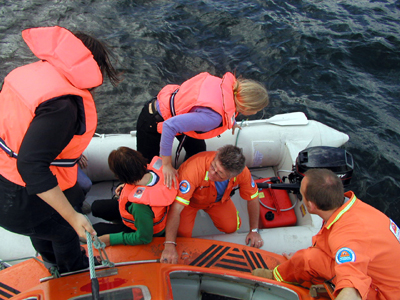
Please tour the http://www.life-boat.org site and visit the Process visa section to make a personal musicalised DNA profile.
Mode #4 ~ SonicLandscapes + AudioNomad.
There follows a generalised description of the “AudioNomad” creative research project into location sensitive immersive audio, delivered via mobile platforms. The second part of the text describes the” Virtual Wall” that we intend to present in 2006/7 with a development period spanning 2005/6.
Part 1 ~ AudioNomad ~ a background.
“Audio Nomad” is the generic title for a three-year R+D programme into the Creative and Technological potentials of immersive and location sensitive Audio. The research is a collaboration between the Artist Dr. Nigel Helyer (Sonic Objects; Sonic Architecture) and the University of New South Wales (Prof. Chris Rizos of the Satellite Navigation and Positioning Lab (S.N.A.P.) and Dr. Daniel Woo of the Human/Computer Interface Lab (H.C.I.). The project is co-funded by the Australia Council and the Australian Research Council under an Arts and Science linkage scheme entitled “Synapse”.
The current “Audio-Nomad” collaboration is a direct continuation of the previous collaborative research between Nigel Helyer, UNSW and Lake Technology that successfully developed the “SonicLandscapes” prototype Virtual Audio Realty navigation system.
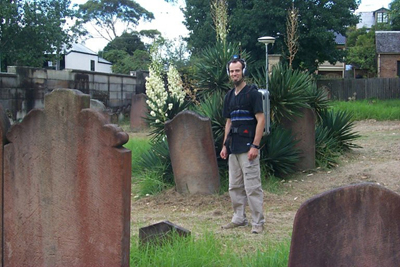
The original ‘proof of concept’ SonicLandscapes VAR device (2001) giving 2cm of terrestrial accuracy1 degree of rotational accuracy (at 30 Hz) and equipped with fully immersive surround sound delivered via normal head-phones (Lake Dolby Headphone). The4 system delivered an extremely convincing ‘sonic landscape’ transforming the physical environment with a fictional audio over-lay.
From the perspective of the user experience, the systems that we are developing are all intended to allow a participant to enter into a world of extended audio narratives and soundscapes, whilst negotiating normal everyday surroundings. The interface is designed to be unobtrusive; in fact the main navigation activity is the simple act of walking, without the distractions of text, images or buttons. The soundscape is delivered as virtual surround-sound via headphones and the audio events appear to be anchored at specific points in real space and share similar acoustic properties to the surrounding ambient sounds. Thus the listener experiences a seamless nexus between the real and the virtual. In the SonicLandscapes example above, grave markers in the churchyard can tell stories, statues deliver poetic verse and monuments play cello solos! The participant therefore enters a type of parallel audio world, in which memories of particular sites can be invoked alongside quotient reality.
AudioNomad ~ Creative and Technological Objectives.
The first thing to note about AudioNomad is that as a federally supported R+D programme it has an unusually powerful synergy between Artistic and Technological developments.
The AudioNomad team is developing a series of projects over the next three years specifically designed to balance creative and conceptual endeavours with the development of technological platforms. Our principle will be to marry creative and technological approaches, working as a cross-disciplinary team that will develop the philosophical, creative and technological systems within the critical arena of public cultural events and major international electronic-arts festivals. We have recently made a public debut at ISEA2004 (International Symposium of Electronic Arts) with “Syren” a
surround-sound project, mounted on the helicopter-deck of the Baltic cruise ship “Opera”. Here the ship was tracked by GPS through a sonic-cartography triggering a complex spatialised soundscape that stretched from Helsinki to Stockholm and back to Tallinn).
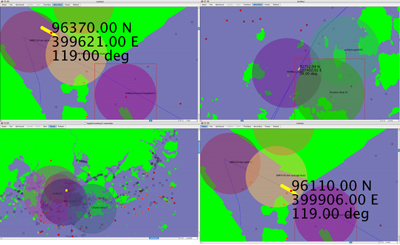
Screen images from the spatial audio editor interface developed for “Syren”. The small yellow object is a scale representation of the cruise liner “Opera” tracking through the Finnish archipelago, the numbers represent the ships heading and position. Circular objects represent the position of ‘sound-stacks’ (groups of audio files) with the circumference acting as an on/off trigger activated by the ships position.
Aside from producing works for such high profile public projects, we have a series of fundamental R+D objectives, which enable and support these public expressions.
These objectives include ~ The conceptualisation of innovative methods for creating sound compositions that operate geo-spatially, that are non-linear and that address the challenges of mobile ‘users’.
The development of editing and compositional interfaces, for 3D audio editing, appropriate for these new conditions. Such interfaces include gestural editing and systems appropriate for in-situ GPS tracked soundscape design (i.e. composition in the field).
One of our primary technical interests is in the development of primarily non-visual interfaces for the composition, editing and run-time virtual/augmented audio reality systems. This would include 3D haptic spatial audio editing and other gestural editing devices, voice interface editing and general research into non-linear sound compositional strategies.
The use of wireless technology for audio-data up and downloads, the use of “Pseudolite” technology for precision spatial tracking and the integration of location determination technology with mobile wireless connectivity/IT platforms.
An important outcome of this project is a powerful, flexible and robust system that is capable of generating (composing and editing) and manifesting (exhibiting and demonstrating) an innovative method for spatially distributed soundscapes.
A secondary development is research into Spatial Information of other data-forms; say images, texts and other media, allowing the system to be used (for instance to up/download geological data in- the field, etc).
A truly mobile and miniature format system obviously lacks the storage capacity for large soundscape projects, as it does the capacity to interact with changing conditions (i.e. content updates etc) or multi-user interconnectivity and associated processing.
Our aim is to develop wireless systems, which automatically update the content cache of a mobile unit dependant upon its position in the real world. Such a system would potentially allow user input and contribution to a global content database, as well as providing the basis for user interactions.
AudioNomad also has strong interest to explore and develop the potentials of remote collaborative workspace methodologies and technologies – allowing team members to work together at a distance on complex sound designs and spatial mappings.
Definitions of Virtual Audio Reality and Augmented Audio Reality.
Virtual Audio Reality refers to a system that immerses an auditor in a dynamic and spatially active audio environment, which may or may not be linked to a corresponding visual domain (real or virtual). In this case the audio is intended as a total environment and supplants any local or ambient sound.
Augmented Audio Reality refers to a system in which allows an auditor to experience ambient/local sounds whilst simultaneously overlaying these with additional audio information. AAR generally operates in a real-world visual context.
Part 2 ~ The “Virtual Wall” project.
“Virtual Wall” is an augmented audio reality artwork proposed for the Mitte in Berlin. The project will trace the physical course of the (now absent) Berlin Wall and will inhabit the (few) remaining vacant spaces and the (predominantly) re-built areas of the city centre with a complex location sensitive soundscape formed from a mixture of historical material (oral histories and public speeches for example) with fictional audio narratives, music and ambient effects.
The other Berlins:
Beyond the historical stereotypes of a politically divided culture and the symbolic separation of the capitol the creation of a divided Berlin was essentially the division of people and families generating a massive social disruption (piled upon an already traumatised city). So in a sense, we have two Berlins – the personal and social Berlin – and the public, Propaganda Berlin, eventually these two became hopelessly confused.
The “Virtual Wall” will operate in the space between the public and private lives – balancing material from public broadcast sources with intimate stories and characters. The soundscape will draw heavily upon accurate oral-history material that will be interwoven with strands of a more poetic nature, drawing in musical and ambient sonic material.
Conceptual and Sonic Objectives.
This proposal places a strong emphasis on a highly imaginative and creative approach to sound composition and sound design in order to highlight the potential of this emergent field of geo-spatially located virtual audio. Unlike conventional sound-design or musical composition, geo-spatially located audio needs to be highly sensitive to its environmental and architectural context as well as to the fundamentally non-linear manner in which the auditor may interact with the content via the position, speed and heading of the auditor in relation to the architectural/urban environment.
Conceptually and sonically, the principal challenge of the proposal is to develop a ‘compositional’ strategy able to deliver a non-linear but coherent ‘field’ of audio. The system will provide the possibility for both (apparently) fixed and mobile audio events, as well as several mechanisms for sequencing sound files in a variety of ways.
Another significant conceptual challenge will be to re-conceptualise sonic events in the mould of a topology, thus escaping the view of the world (and of sound composition) which is ‘object’ oriented ~ but rather moving towards one which is relational and inextricably connected – both through both spatial and temporal axes.
Throughout the project development special attention will be paid to local narratives, oral histories, and spatial and architectural ‘keynote’ elements of the soundscape. Narrative themes will be developed form historical and cultural research and we anticipate forming partnerships to undertake both the background research and for the generation and composition of content (recorded as multi-lingual voice narratives).
As an element of our on-going development we are experimenting with server based digital storyboarding and soundscape compositional techniques and anticipate that the majority of the project development will be conducted in this manner, facilitating collaborative work from remote locations.
Objects of focus ~ Complexity, Time and Space.
The construction and the experience of our project will occur within both a time domain and a spatial domain. Whilst the experience of audio is by nature temporal and to a degree linear, the experience of a spatially constructed soundscape is totally unpredictable and incorporates many features of non-linear systems. The content of the work itself will address both historical and contemporary time periods adding further levels of temporal complexity.
We may, for example, take in the pre-wall events of the blockade of Berlin that resulted in the Berlin Airlift. There are also four significant stages of Wall construction and modification that range from 1961 until 1975. The wall structure itself provides a focus around the checkpoints that are a source of narrative events, of escape attempts etc. And of course, the Grand Finale – the Wall Opening and it’s subsequent destruction – and of course we may choose to ‘tag’ our project to one of the few remaining sections of wall.
Although the work is spatially bounded (albeit in a large area some 4,000 metres by 400 metres) and has a principal vector in the path of the wall, the compositional structure does not impose a spatial hierarchy or even propose an explicit spatial structure. Spatio-temporal complexity is generated by both the pace of walking through the physical landscape (and ipso facto through the soundscape) in combination with the temporal duration of individual sound events and their position which may be fixed in absolute space, coupled to a trajectory or positioned relative to the participants position.
One of the principal challenges is to decide how to compose or layer material from different historical phases of the Wall – should they be arranged spatially, or should they be cued via a temporal mechanism? Should they be accessed in a chronological order ~ or should there be a fluid mechanism which collides temporal frames of reference?
Technical and Research Objectives.
“Virtual Wall” proposes a range of complex technological challenges. Our proposed project area is a 4Km section of the wall running either side of the new Parliament building and thus needs to incorporate a huge amount of audio data, distributed over a large geographical area (1, 600, 000 square metres).
Creatively the project will develop compositional techniques for managing the admixture of oral histories and fictional narratives associated with the histories of these locations, but will also need to address the pragmatics of cueing and guiding the users over a large geographical terrain, and focussing the participant on the path of the vanished wall (a sharply defined linear track). Naturally there are only certain ‘natural’ limits to where a participant can walk (e.g. the river) and many competing points of interest that will be beyond the scope of our project, therefore compositional and psychoacoustic designs need to be developed to indicate the project boundaries and retain the auditor’s interest and concentration.
Issues of location will probably be solved by the new generation of “Pseudolite” ~ highly accurate ground-based GPS emitters which can give a centimetre accuracy. We intend to employ Wireless LAN technology to supply the vast amount of audio data required by the geographical size of the project, and to supply tracking information for individual participants to facilitate a level of ‘customisation’ for each audio experience (dependant upon the track and sites visited by each participant).
There is further scope in this project to consider the incorporation of visual (screen based) components in the form of detailed map graphics and visual documents geo-spatially linked to specific locations as well as other forms of historical and /or educational information.
ENDS.